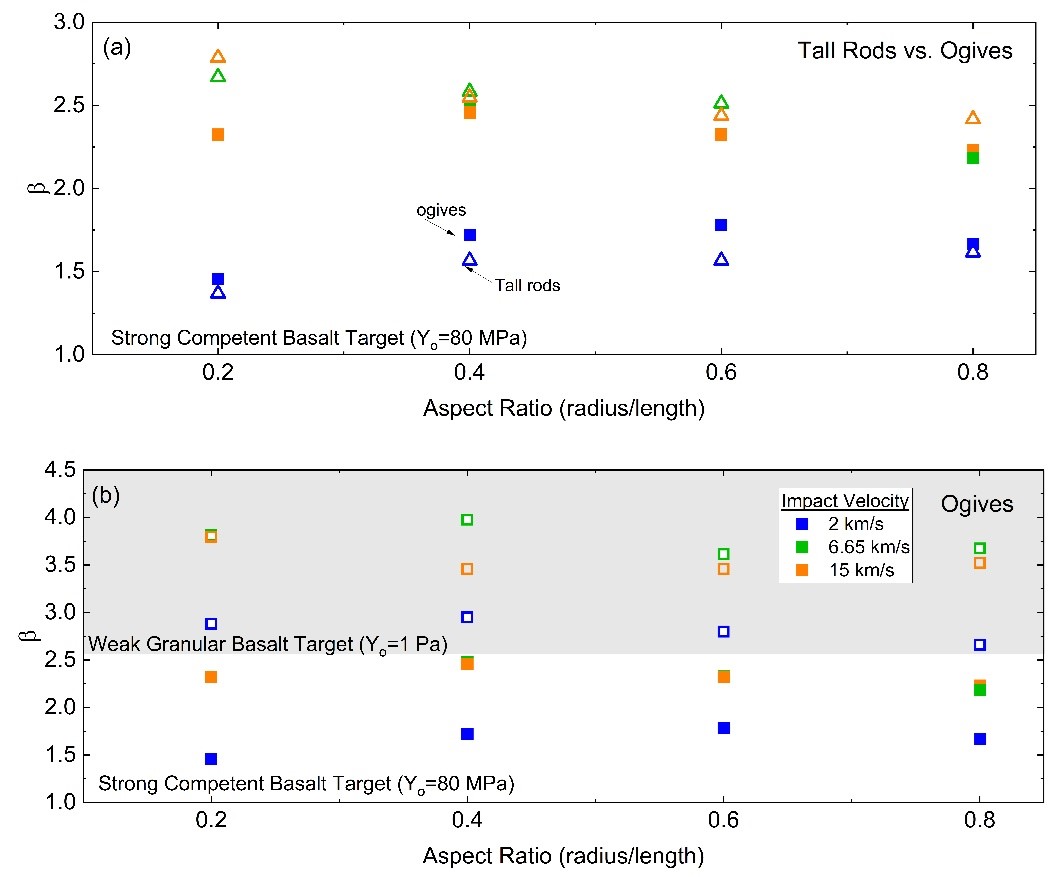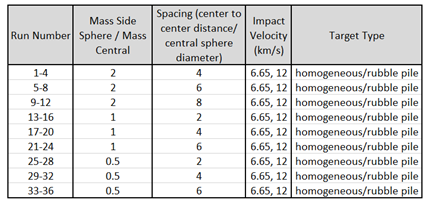Designing the next generation kinetic impactor for planetary defense
- Johns Hopkins University Applied Physics Lab, Space Exploration Sector, United States of America (raymond.lu@jhuapl.edu)
DESIGNING THE NEXT GENERATION KINETIC IMPACTOR FOR PLANETARY DEFENSE
Raymond Lu(1*), Mallory E. DeCoster(1), Julie Peck(1), Tony Le(1)
(1)Johns Hopkins University Applied Physics Laboratory, 11100 Johns Hopkins Road Laurel, MD 20723,
*Raymond.Lu@jhuapl.edu
Keywords: Kinetic Impactors, Hypervelocity Impacts, Hydrocodes, planetary defense
ABSTRACT
On September 26, 2022, NASA successfully executed the Double Asteroid Redirection Test (DART) mission, a full-scale planetary defense demonstration of the kinetic impactor technology that intentionally collided a spacecraft into a small asteroid to change its orbit. However, the DART mission was a demonstration of one kinetic impactor design impacting a singular target morphology, begging the question: is it possible to optimize a kinetic impactor design to maximize deflection? Further, it remains an open question whether the kinetic impactor projectile can be optimized based on the intended target asteroid morphology and/or surface structure. To investigate this, we used CTH hydrocode simulations which examined the role of mass placement within a single projectile and a cluster of multiple projectiles on the deflection efficiency resulting from a hypervelocity kinetic impact with a variety of asteroid-like targets ranging from homogeneous monoliths to sandy rubble piles.
It is well known that the total projectile mass and impact velocity greatly influence the effectiveness of a kinetic impactor; however, these parameters are typically limited by the launch and target asteroid orbit considerations. For this work, we focused on the effects of mass placement within a spacecraft (projectile) design and performed numerical studies of projectiles of varying geometry while keeping the projectile mass constant. To systematically vary the projectile geometry, we considered both tall rods with varying aspect ratios (AR) (calculated as radius/length) and ogives where we varied the AR and the angle between the ogive leading edge and the target (α). Our results showed that the projectile geometry effect was subtle compared to the effects of target material parameters (cohesion, porosity, internal friction, etc.), which is in line with previous reports, however, when there is a projectile effect, it is most pronounced in weaker (i.e. yield strength of 1 MPa) granular (unconsolidated targets) compared to strong monolithic targets. While the role of α on deflection efficiency was complex, our results showed that for hypervelocity ( 6.65 km/s) impacts, smaller aspect ratios led to larger amounts of total ejecta mass and larger momentum efficiency factors (β). Figure 1 (a) indicates that by and large, tall rods and ogives resulted in similar β’s as a function of impact velocity, with the tall rods slightly outperforming the ogives except for when the AR was small (i.e., the tallest/skinniest projectile with AR=0.2). In this case, the tall rod drastically outperformed the ogive with equivalent AR by ~20%, and this projectile outperformed the other tall rods by 12%. Further, Figure 1 (b) illustrates that the projectile geometry effect on β was closely coupled to the target material properties, where the effect of projectile aspect ratio was more pronounced in weaker granular target compared to the strong competent target.

(Figure 1. (a) β resulting 500 ms post impact for simulations of impacts of tall rods (triangles) compared to ogives (squares) of varying aspect ratio at three different impact velocities (2.00 km/s, 6.65 km/s, and 15.00 km/s) into strong competent basalt targets. (b) β resulting 500 ms post impact for hypervelocity impacts of ogives of varying aspect ratio at three different impact velocities (2.00 km/s, 6.65 km/s, and 15.00 km/s) into two different types of targets (strong and weak basalt). The open symbols are indicative of impacts into weak granular basalt targets with a cohesion (Yo) of 1 Pa, and the solid symbols are indicative of impacts into strong competent basalt with a cohesion (Yo) of 80 MPa.)
In addition to the dominant role of target material properties in affecting deflection efficiency, recent work has shown that the near surface structure of the asteroid target also plays a crucial role in affecting β. Therefore, it may be possible to improve a kinetic impactor’s efficiency by using a set of clustered projectiles, rather than a singular projectile, to mitigate the armoring effect on β that an impact directly into a large surface boulder might have. We used CTH to investigate the effects of spacing and mass distribution (while keeping the total projectile mass constant) on a cluster of three spherical projectiles impacting homogeneous and rubble pile targets. Figure 2 shows three examples of the projectile clusters under consideration and outlines the full 2D axisymmetric test matrix. For each cluster of projectiles, we vary both the ratio between the mass of the side spheres and the central sphere (M) (while keeping the total mass constant) and the spacing between the spheres, reported as the ratio, S, between the center-to-center distance of the central sphere to the auxiliary sphere with respect to the diameter of the central sphere. Impacts performed into homogeneous and rubble pile targets will be useful to understand the role of near surface structure on projectile geometry optimization. These results will inform both future numerical efforts and future experimental investigations of kinetic impactor effectiveness.

(Figure 2. (top) Illustrations of projectile geometry clusters with varying mass ratios (M) and spacing ratios (S). (bottom) The full CTH test matrix for investigating the effects of projectile clusters on deflection efficiency into homogenous and rubble pile asteroid-like targets.)
How to cite: Lu, R.: Designing the next generation kinetic impactor for planetary defense, Europlanet Science Congress 2024, Berlin, Germany, 8–13 Sep 2024, EPSC2024-558, https://doi.org/10.5194/epsc2024-558, 2024.